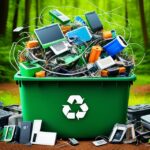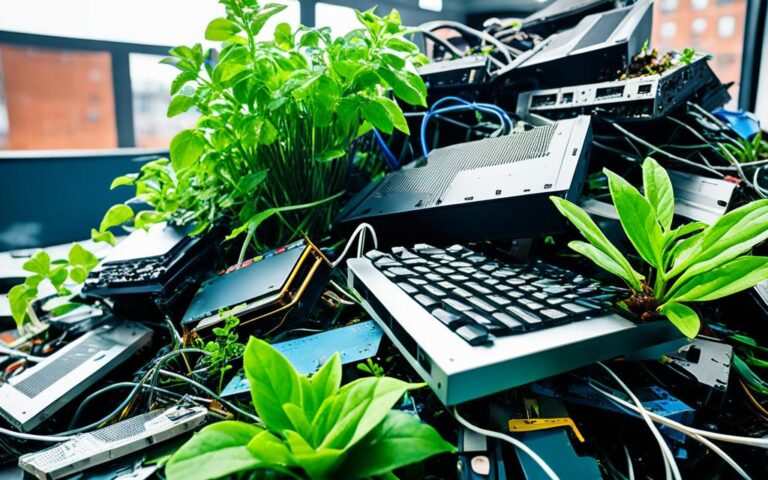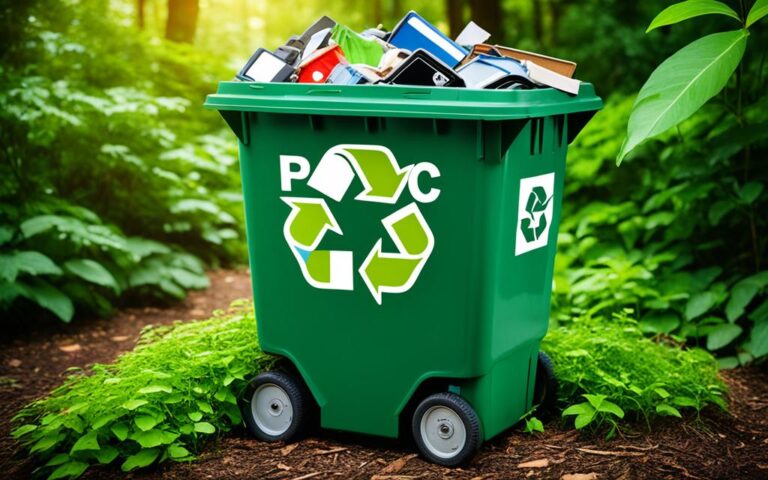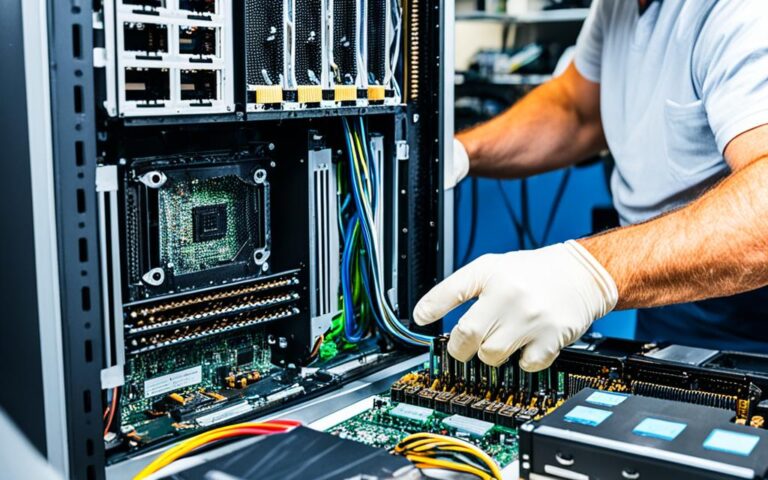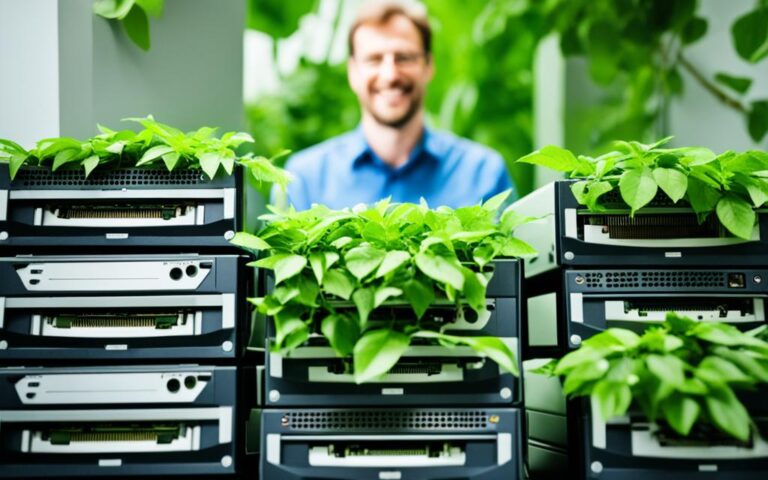The Green Path: Eco-Friendly Computer Disposal Techniques
In today’s technologically advanced world, computers have become an integral part of our lives. However, when it comes to disposing of old computers, it’s crucial to follow sustainable and eco-friendly methods. The improper disposal of electronic waste, commonly known as e-waste, has detrimental consequences for the environment and human health.
E-waste constitutes a significant portion of the world’s toxic waste, accounting for 70% of the total. These discarded devices often contain harmful toxins such as cadmium, lead, mercury, and flame retardants. When improperly disposed, these toxins can seep into the soil and water, polluting ecosystems and harming wildlife.
Addressing the challenges of e-waste disposal requires cost-effective solutions and the establishment of proper infrastructure. That’s where Eco Green Computer Recycling comes in. They provide a well-managed, eco-friendly disposal pathway for computers and other electronic devices, prioritizing data security and responsible waste management.
Businesses should be proactive in implementing commercial waste disposal management to benefit from energy savings, pollution reduction, environmental conservation, and even employment creation. By choosing sustainable practices, we can pave the way towards a greener future.
Join us on the green path of eco-friendly computer disposal as we explore the various aspects of e-waste, its toxins, the challenges we face, and the importance of responsible disposal methods.
What is Electronic Waste?
Electronic waste, commonly known as e-waste, refers to all electronics that are no longer used, unwanted, or no longer functional. It includes various devices such as computers, mobile phones, TVs, and household appliances. E-waste is a growing concern due to its environmental impact and the presence of hazardous substances.
E-Waste Definition
Electronic waste (e-waste) – all electronics that are not used, unwanted, or no longer functional.
E-waste contains a range of chemicals and materials that can be harmful to human health and the environment if not properly disposed of. Some of the hazardous substances commonly found in e-waste include:
- Mercury: A toxic heavy metal used in devices like fluorescent lamps, thermostats, and batteries.
- Lithium: Found in batteries, lithium can cause chemical reactions when improperly disposed of, leading to fires or explosions.
- Copper: Although not as toxic as mercury or lithium, copper is still a valuable material that can be recycled if properly recovered from e-waste.
When e-waste is disposed of improperly, it can have severe consequences for the environment. Land, air, and water contamination are the primary outcomes of improper e-waste disposal. Leaching of hazardous chemicals from e-waste into the ground can contaminate soil, affect groundwater quality, and pose a risk to nearby ecosystems.
Improper e-waste disposal can lead to land, air, and water contamination, endangering both the environment and human health.
It is crucial to handle and dispose of e-waste responsibly to minimize its negative impact on the ecosystem and prevent the release of toxins.
Toxins in Electronic Waste
E-waste is a source of various toxic substances that can be harmful to both humans and the environment. When not disposed of properly, these toxins can find their way into the air, land, and water, posing serious risks.
| Toxic Substances | Effects |
|---|---|
| Mercury | Affects the central nervous system and can cause developmental disorders. |
| Lead | Can cause neurological damage, especially in children. |
| Brominated Flame Retardants | Persistent in the environment and can accumulate in living organisms, leading to hormonal disruptions. |
| Cadmium | Known to cause kidney and lung damage when exposure is significant. |
Toxins in E-Waste – mercury, lead, brominated flame retardants, and cadmium.
These toxins can enter the environment through various pathways, such as leaching from landfills or incineration processes. Once released, they can contaminate water bodies, soil, and air, creating a significant risk to ecosystems and human health.
The Toxins that E-Waste Hides
Modern technology and electronics contain a range of harmful chemicals that pose a significant threat to the environment. When electronic waste, or e-waste, is improperly disposed of in landfills, these toxic substances can leach into the soil, contaminating the surrounding areas and creating a serious environmental impact.
The toxins found in e-waste include cadmium, lead, and brominated flame retardants. Cadmium, a highly toxic heavy metal, is commonly used in older electronic devices, such as batteries. Lead, another hazardous heavy metal, is found in older computer monitors, cathode ray tubes (CRTs), and solder. Brominated flame retardants, used to reduce the flammability of electronic components, can be found in circuit boards, cables, and plastic casings.
When these chemicals leach into the soil, they can contaminate water bodies, such as rivers and lakes. This contamination not only affects aquatic ecosystems but also poses a threat to wildlife that relies on these water sources. The toxins can bioaccumulate in the food chain, leading to long-term adverse effects on both animals and humans.
The Environmental Impact of E-Waste Toxins
The environmental impact of e-waste toxins is significant and far-reaching. The leaching of these chemicals into the soil can lead to soil degradation and loss of fertility, making it difficult for plants to grow. Additionally, the contamination of water bodies can harm aquatic organisms, disrupting delicate ecosystems and reducing biodiversity.
The improper disposal of e-waste not only poses risks to the environment but also to human health. Exposure to these toxic substances can lead to various health problems, including respiratory issues, neurological disorders, and even cancer.
To mitigate the harmful impact of e-waste toxins, proper e-waste disposal methods are crucial. Responsible recycling and disposal of electronic devices ensure that these harmful chemicals are kept out of landfills and the environment. Additionally, recycling helps recover valuable materials from e-waste, reducing the need for new resource extraction and contributing to a circular economy.
By opting for eco-friendly e-waste disposal methods, we can protect the environment, safeguard human health, and create a sustainable future for generations to come.
| Toxins | Common Sources | Environmental Impact |
|---|---|---|
| Cadmium | Batteries, older electronic devices | Soil contamination, water pollution, bioaccumulation |
| Lead | Computer monitors, CRTs, solder | Soil contamination, water pollution, health risks |
| Brominated Flame Retardants | Circuit boards, cables, plastic casings | Soil contamination, water pollution, health risks |
Challenges Faced for E-waste Disposal and Elimination
E-waste disposal poses significant challenges globally, with various factors impeding effective elimination methods. These challenges include high recycling costs, inadequate waste disposal infrastructure, and insufficient environmental standards.
The Costly Conundrum of Recycling
Recycling e-waste can be a costly endeavor, often surpassing the revenue generated through recycling efforts. The complexities associated with extracting and processing valuable materials from electronic devices, coupled with the lack of standardized recycling procedures, result in high recycling costs. This financial burden discourages individuals and businesses from actively participating in e-waste recycling programs.
Insufficient Waste Disposal Infrastructure
In many countries, the lack of proper waste disposal infrastructure exacerbates the e-waste problem. The absence of designated collection centers, recycling facilities, and reliable transportation networks leads to the accumulation of e-waste in landfills or substandard disposal sites. Without a robust waste disposal infrastructure, it becomes challenging to manage and process e-waste effectively.
Environmental Standards and Compliance
Another significant challenge faced in e-waste disposal is the lack of consistent environmental standards across different regions. In areas where environmental regulations are insufficient or not strictly enforced, improper e-waste disposal becomes more prevalent. This non-compliance results in hazardous substances leaching into the environment, polluting soils, contaminating water bodies, and posing risks to human health and wildlife.
Overcoming these challenges requires a collaborative effort among governments, businesses, and individuals to invest in sustainable waste management strategies, strengthen recycling initiatives, and enforce stringent environmental regulations.
| Challenges | Impact |
|---|---|
| High recycling costs | Discourages recycling practices |
| Lack of waste disposal infrastructure | Accumulation of e-waste in landfills |
| Insufficient environmental standards | Improper e-waste disposal and pollution |
“The proper management and disposal of e-waste demand proactive measures, focusing on reducing costs, enhancing waste disposal infrastructure, and enforcing robust environmental standards.” – GreenTech Recycling Solutions
Conclusion
The world generates millions of tons of e-waste annually, posing a significant challenge to our environment. However, by adopting eco-friendly disposal methods, we can reduce the environmental impact and create a greener future.
Responsible disposal methods are crucial in combating the growing e-waste problem. Instead of simply discarding electronic devices, there are several options for eco-friendly disposal. One option is donating or selling usable devices, allowing them to have a second life. Another option is reinventing old technology through refurbishment or repurposing. Additionally, ethically disposing of broken devices ensures proper handling of hazardous materials.
Recycling, reducing, and reusing e-waste play a vital role in sustainable waste management practices. By recycling electronic devices, we can recover valuable resources and minimize the need for raw material extraction. Reducing consumption by extending the lifespan of electronics through repairs or upgrades also helps in the conservation of resources. Finally, reusing e-waste by repurposing or donating devices reduces the demand for new products.
It is essential that individuals and businesses prioritize responsible e-waste disposal to contribute to a greener future. By embracing eco-friendly practices, such as proper recycling and reuse, we can make a tangible difference in reducing e-waste’s environmental impact. Together, let us take proactive steps towards a more sustainable and responsible approach to e-waste disposal.
FAQ
Why is a proper waste disposal system important?
A proper waste disposal system is essential for keeping the environment healthier and preventing pollution.
What is electronic waste?
Electronic waste, or e-waste, refers to all electronics that are not used, unwanted, or no longer functional.
What are the toxins found in e-waste?
E-waste contains harmful toxins like cadmium, lead, mercury, and flame retardants.
How does improper e-waste disposal affect the environment?
Improper e-waste disposal can lead to soil and water pollution, affecting wildlife and causing harm to the ecosystem.
What are the challenges faced in e-waste disposal?
Challenges for e-waste disposal include high costs and a lack of infrastructure in many countries.
How does Eco Green Computer Recycling offer a solution to e-waste disposal?
Eco Green Computer Recycling provides a cost-effective and well-managed solution for e-waste disposal.
Why is proper data security important when disposing of old electronics?
Proper data security is essential to prevent data theft when disposing of old electronics.
Why should businesses prioritize commercial waste disposal management?
Businesses should prioritize commercial waste disposal management for energy savings, pollution reduction, environmental conservation, and employment creation.
How does improper e-waste disposal contaminate the environment?
Improper e-waste disposal can lead to land, air, and water contamination, releasing harmful toxins into the environment.
How can individuals and businesses contribute to a greener future?
By adopting sustainable practices like recycling, reducing, and reusing e-waste, individuals and businesses can contribute to a greener future.


